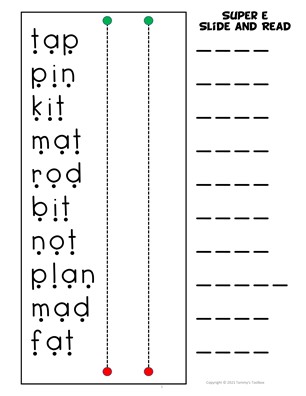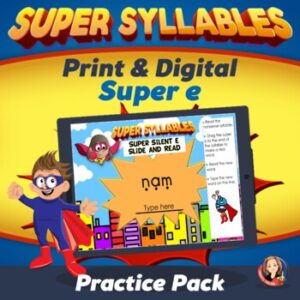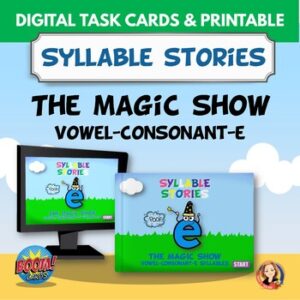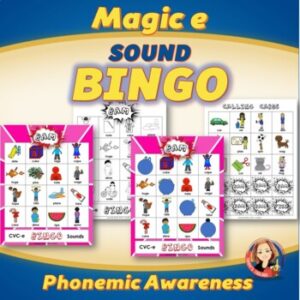The Silent E Rule – How to Teach it to Struggling Readers
Ready for a fun fact? The letter e is the most common letter in the English language! It appears in about 20% of all words. But what does the letter e do? What jobs does it have? Let’s take a look!
The letter e has a lot of jobs? It’s true! For example, it can be a vowel or a consonant. It can also be short or long. And finally, it can be at the beginning, middle, or end of a word. Pretty impressive for just one letter, right?
This blog post will focus on one of the many jobs the letter e has and how you can help your students learn and apply this rule. We’ll also give you some helpful tips on making learning about silent e fun and engaging for kids!
The Many Jobs of the Letter E
- Makes the vowel before it say its name. An example is cape and mine.
- Makes c and g soft. Ice, cage, and dance are examples.
- Keeps i, u, and v from being the last letter. Examples are give and glue.
- Shows that a word is not plural. Dense, moose, and tease are examples.
- Adds vowels to the consonant le syllable. Examples are purple and table.
About the Silent Letter E Rule
The silent e rule states that the e at the end of a syllable makes the vowel before it long or “say its name.” It is the most common job of the silent e and the rule that most children are familiar with. It is often called magic e, silent e, or super e! Some examples of this rule would be cake, bike, cute, and woke.
Students need to be directly taught this rule and given many opportunities to apply this skill to achieve mastery in phonemic awareness and phonics. This will support them as they build on fluency, vocabulary, and comprehension.
Activities to Teach Silent E
Here are some of my favorite activities to teach the silent e rule.
► Use contrasting CVC and CVCe words. This technique helps kids hear how the vowel changes from short to long and emphasizes that the letter e is silent.
 Make a magic e wand that students can put at the end of the CVC word to turn it into a new word.
Make a magic e wand that students can put at the end of the CVC word to turn it into a new word.
Here are some word pairs to get you started.
- pin pine
- tap tape
- rat rate
- man mane
- mop mope
- pal pale
- not note
- rod rode
- rid ride
- mad made
- hid hide
► One of my favorite tools is a tachistoscope for magic e. If you don’t know what a tachistoscope is, Dictionary.com defines it as “an apparatus for use in exposing visual stimuli, as in pictures, letters, or words, for an extremely brief period.” My definition is “an extremely engaging and multisensory way to learn!” And don’t worry, they are easy to make and use. There is a free magic e tachistoscope that you can print and use in my Resource Library. Sign up to get your access code.

More Tips for Teaching Silent E
► Use multisensory instruction that engages more than one sense at a time to help students learn. A multisensory activity can include seeing, talking, hearing, moving, and touching. One example is making a magic e wand. The Magic e makes the vowel sound long and say its name. For instance, rid becomes ride. Spelling the words in colored sand is another excellent strategy!
► Use sound boxes. Show students how the e goes outside the box because it does not make a sound.
► Instead of using sound boxes, use small manipulatives to represent each sound. Segment the word by tapping out the manipulatives (tokens, candy, cubes, etc.).
► Use colored letter tiles to show your students the CVCe pattern (consonant, vowel, consonant, silent e)
► Lead students through reading phrases, sentences, and (eventually) passages made up of decodable words with the sounds directly taught repeatedly along with some irregularly spelled high-frequency words. Students read once for accuracy and again for fluency.
Silent E-Resources
If you need fresh activities to practice CVC-e words (magic e, super e, silent e), these phonological and phonemic awareness resources are perfect.
➠ Check out this video to see some fun ways to teach super e.
One Final Activity
Now it’s time to put what you’ve learned into practice, pulling it all together. The best way to do this is by giving my favorite activity a try- the silent e scavenger hunt! In this activity, students will hunt for words containing a silent e. They can record their findings on a sheet of paper or in a Google doc (or any other online platform). As they find words with silent e, have them underline the letter e and draw a line (macron) over the long vowel. This will give you an idea of which words your students struggle with most when it comes to remembering this rule.
Have fun teaching silent e! Let me know your favorite silent e tricks!
Before you go, see this post on teaching the 6 syllable types.







